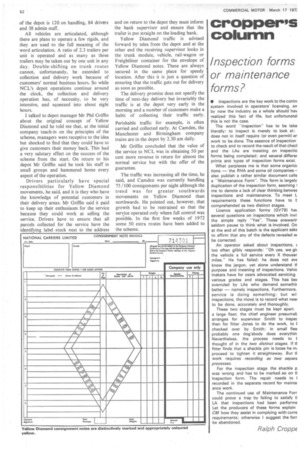cropper's column
Page 54

If you've noticed an error in this article please click here to report it so we can fix it.
Inspection forms or maintenance forms?
• Inspections are the key work to the contr( system involved in operators' licensing, an by now the industry as a whole should hay realized this fact of life, but unfortunatel this is not the case.
The word "inspection" has to be take literally: to inspect is merely to look at; does not in itself require (or even permit) an work to be done. The essence of inspection to check and to record the result of that checl and the LAs are insisting on inspectio forms being completed; and several differer prints and types of inspection forms exist.
What perplexes me is that some organizE tions — the RHA and some oil companies also publish a rather similar document calle a "Maintenance Form". This form is largely duplication of the inspection form, seeming 1 me to denote a lack of clear thinking betwee inspections and maintenance. To meet L requirements these functions have to t comprehended as two distinct stages.
Licence application forms (GV79) hat several questions on inspections which invi. the simple reply "Yes". Those answerin seldom pause to think what is involved. On at the end of this batch is the applicant aske to affirm that any of the defects revealed w be corrected.
An operator asked about inspections. E too often glibly responds: "Oh yes, we gh the vehicle a full service every X thousar miles," He has failed: he does not eve know the jargon, yet alone understand ti purpose and meaning of inspections. Vehic makers have for years advocated servicing various grades and stages. This has be( overruled by LAs who demand somethir better — namely inspections. Furthermore, service is doing something: but wii inspections, the move is to record what nee( to be done, accurately and thoroughly.
These two stages must be kept apart. a large fleet, the chief engineer presumah arranges for supervisor Smith to inspec then for fitter Jones to do the work, to I checked over by Smith: in small flee probably one dog'sbody does everythin Nevertheless, the process needs to I thought of in the two distinct stages. If tl fitter finds that a shackle pin is loose he mi proceed to tighten it straightaway. But ti work requires recording as two separa processes.
For the inspection stage the shackle p was wrong and has to be marked .so on ti inspection form. The repair needs to I recorded in the separate record for mainte ance work.
The continued use of Maintenance Forr could prove a trap by failing to satisfy tl LA that inspections had been performe Let the producers of these forms explain CM how they assist in complying with curre requirements; otherwise I suggest the forr be abandoned.
Ralph Cr0pp6










































































































